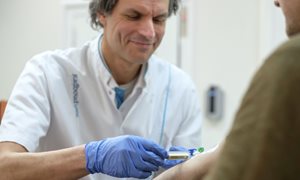
In patients undergoing skin reconstruction after a burn, a single operation can be enough to replace both the lower and upper skin. This is what researchers from Radboud university medical center write in a scientific article. Patients not only stay in the hospital a week less, they also suffer less scarring.
A patient with a serious skin defect, such as a burn or bacterial infection, may be eligible for skin reconstruction. A plastic surgeon then places a piece of skin from elsewhere on the body at the site of the wound. Unfortunately, that process is not ideal. The transplanted skin can become tight, especially if the reconstruction was done near a joint. In addition, the new piece of skin can cause excessive scarring. This does not look pretty and can negatively affect the function of the new skin.
New subcutaneous tissue made from donor skin
Fortunately, there is progress in the process of skin reconstruction, says Prof. Dr. Dietmar Ulrich, professor of Plastic and Aesthetic Surgery and head of the Department of Plastic Surgery at Radboud university medical center. "It is now common to stretch the piece of skin that is transplanted by making holes in it, so that a small piece of skin can still cover a larger wound. But such a piece of skin transplanted in this way often feels tight," says Ulrich. "With a severe skin defect, such as a severe burn, not only is the epidermis damaged, but also the layer of skin below it. That contains all the glands and the elastic connective tissue that keeps the skin supple." Colleagues from his department, therefore, in collaboration with the Euro Skin Bank, researched replacing this layer of skin with a prepared hypodermis, made from donor skin and processed so that it no longer contains cells from the donor. "In that prepared subcutaneous skin, body-own cells and vessels can grow, making the final skin layer firmer and more supple."
One surgery leads to better quality scars
Reconstructing the skin with such a piece of prepared subcutaneous tissue requires two surgeries, Ulrich says. "First, we clean the wound, then we attach the prepared subcutaneous skin to it. The original idea was that it takes a week for cells, connective tissue and capillaries to grow in, and then we can close the wound with the new epidermis."
Ulrich and his colleagues are now showing that it is possible to successfully apply this technique in a wide range of patients with just one operation. To do so, they conducted clinical studies among ten patients, ranging in age from three weeks to 77 years old, with different types of causes of skin defects such as burns, wounds after an accident, or after a serious bacterial infection. "We saw that in all patients 98 percent of the skin successfully ingrown," says Ulrich. "In addition, the quality of the scars was better than after two surgeries."
Next study
The next step for Ulrich is to scale up his research so that the longer-term effects become clear as well. "We are starting a larger study with 100 patients, in collaboration with the pediatric burn center at the Radboud university medical center and Amalia Children's Hospital," Ulrich says. "In that study, we want to expand the application of using the prepared skin layer and study the effect on scar quality. In doing so, we will see the patients for a year longer: up to two years after surgery."
The study by Ulrich and his colleagues makes it clear that single surgery is an interesting option for patients undergoing skin grafting. This has significant implications for the patient's rehabilitation process, Ulrich says. "The patient spends a week less in the hospital, and undergoes one less operation. That not only saves discomfort and recovery time for the patient, but it also reduces the risk of infections."
About the publication in Cell and Tissue Banking
Reconstruction of full thickness wounds using glyaderm in a single-staged procedure - Melissa de Henau, Anne Sophie Kruit, Dietmar J O Ulrich. DOI: 10.1007/s10561-021-09907-x.
-
Want to know more about these subjects? Click on the buttons below for more news.
More information
Pauline Dekhuijzen

wetenschaps- en persvoorlichter
Related news items

More accurate surgery with the Anatomy Projector
30 May 2022The Anatomy Projector, developed at the Radboudumc, allows surgeons to operate much more accurately with projected augmented reality.
go to page




